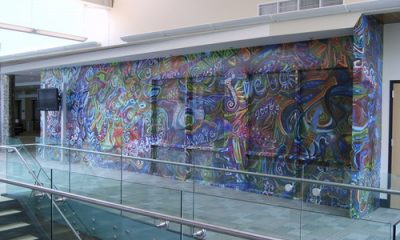Today was the first day of an historic event for the sign industry as the Signage Foundation Inc. joined with two University of Cincinnati (UC) colleges in presenting the 2009 National Signage Research & Education Conference on the UC campus. Although the full contingent of expected sign companies and planners weren’t present for this half-day session, the mix nonetheless represented myriad "stakeholders," to the delight of Gemini Inc. founder Jim Weinel, who made all of this possible.
In the past two years, Weinel’s incredibly generous donations created endowed chairs for UC’s School of Business and also Design, Art, Architecture and Planning (DAAP). Professor Robert Probst, the dean of DAAP (and a judge in Signs of the Times magazine’s annual sign-design contest some 15 years ago) demonstrated his appreciation of signage with a presentation of sign-design projects that he and DAAP students have created over the past decade. Like Weinel, he extolled the tremendous potential of industry/academia synergies.
The presence of numerous DAAP students was perhaps the most historic part of the day. In more than 20 years, I have never spoken to a planner who received any information about signage while in college.
Mark Olinger, the director of the Dept. of Planning & Community & Economic Development for the college town of Madison, WI (Univerisity of Wisconsin), discussed the city’s recently enacted sign code (August 1), the first revision in more than 40 years. While I was quite pleased to hear how the ruling Urban Design Commission (UDC) acknoledges the value of signage, my joy was similarly tempered by the unbridaled subjectivity which determines signage approval. Similary, while electronic message centers (EMCs) are allowed in some areas, the dwell time is one hour, which clearly demonstrates misunderstanding of EMCs’ benefits.
Some decisions seem quite arbitrary. Although Olinger affirmed that visual acuity is duly considered (setback, speed of traffic, etc.), the UDC inexplicably deplores ground signs. I haven’t looked it up yet, but Olinger told me the new code can be viewed online on the Madison city website, under "codes," in Chapter 31.
Olinger presented photos of approximately a dozen attractive signs, and then admitted that all but one would be illegal under the current sign code. That’s where the UDC could step in and approve a sign. (Legal, non-confomring signs are grandfathered automatically.) The only problem is the capriciousness of such decisions.
Advertisement
Hearing Olinger speak and, more importantly, honestly answer questions, provided sign companies with a good glimpse of the planning process. Simiarly, and to his credit, Olinger seemed exceedingly open to any documentation that the rest of the conference would provide. Tune in again tomorrow for a subsequent report.
Here’s a recap of the second day.

 Photo Gallery1 week ago
Photo Gallery1 week ago
 Ask Signs of the Times2 weeks ago
Ask Signs of the Times2 weeks ago
 Paula Fargo1 week ago
Paula Fargo1 week ago
 Real Deal4 days ago
Real Deal4 days ago
 Photo Gallery1 week ago
Photo Gallery1 week ago
 Women in Signs2 weeks ago
Women in Signs2 weeks ago
 Women in Signs1 week ago
Women in Signs1 week ago
 Signs of the Times1 week ago
Signs of the Times1 week ago











